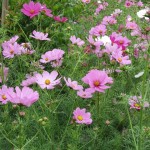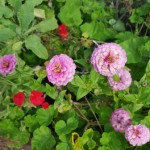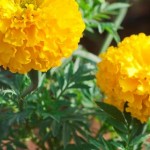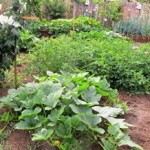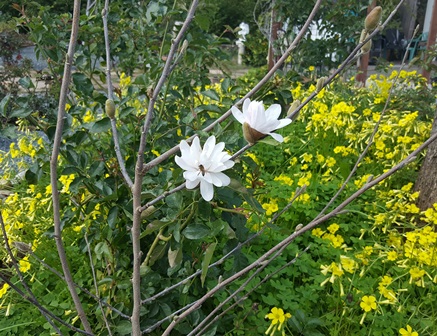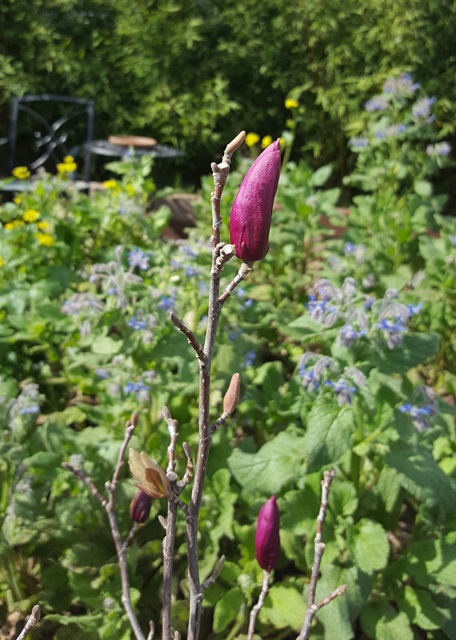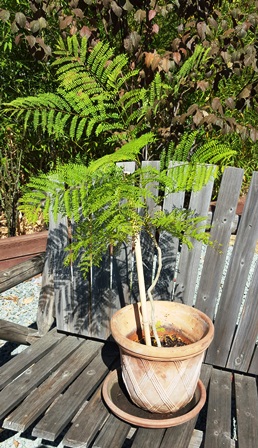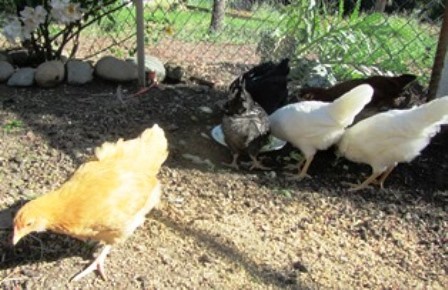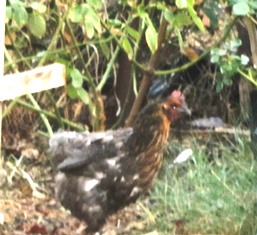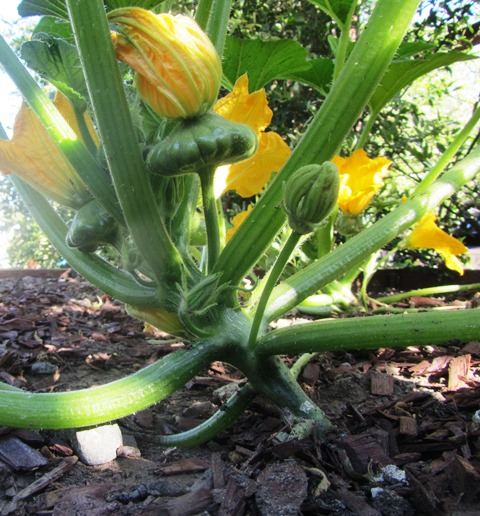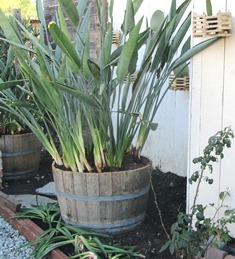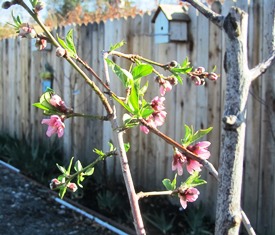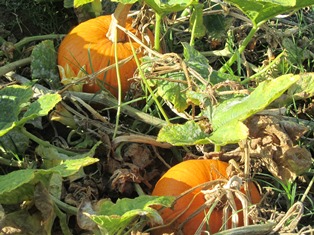Four Reasons to Buy Bare-Root Plants
Mid-February marks the beginning of bare-root season in the Bay Area. Growers ship roses, fruit trees, grapes, and berries in late January through February and March to local nurseries and DIY garden centers. By April, often sales of unsold bare-root plants begin. There are at least four good reasons to buy bare-root plants before spring officially arrives.

- When you buy bare-root trees, berries, grapes, and other plants in late winter (here in the Bay Area), you’ll pay less for them than you will if you wait until the start of spring. The purchase price increases later in the season. When the plants begin leafing out, nurseries will place unsold bare-root plants in pots. Potting an unsold plant involves extra labor as well as the costs for the pot, soil and amendments, mulch, and possibly stakes. Those costs are passed to the shopper.
2. It’s easy to place a bare-root tree right into your garden before its sap is flowing. When it is still “asleep,” it’s not as susceptible to cold and and won’t need as much water as it will when the weather is warm, the plant has leafed out, and the roots are growing and spreading.
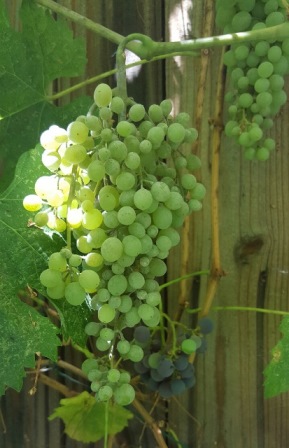
varieties of bare-root grapes.
3. Bare-root buys you time. If you are still planning your garden, you can “heal in” a bare-root plant until you are ready to put it in your garden. You just need to excavate a trench in which you temporarily place the bare-root plant. Mound soil over the roots and water. Let the plant rest until you prepare the permanent planting hole.
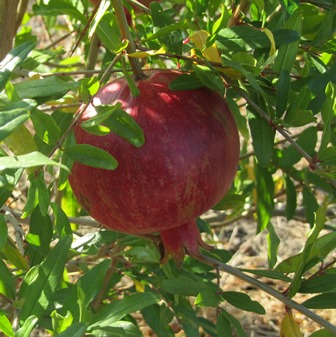
popular because they remain small and fruitful for years.
4. You have an opportunity you won’t get again to inspect the health of the root and its growth. With a bare-root plant, the roots can be examined for problems such as decay or damage. Using sharp pruning shears, you can cut away problem issues. When you buy an already potted plant, you won’t have this option.
Take a moment to visit your local plant seller, nursery, or DIY center to see what plants are available right now. Enjoy the season.
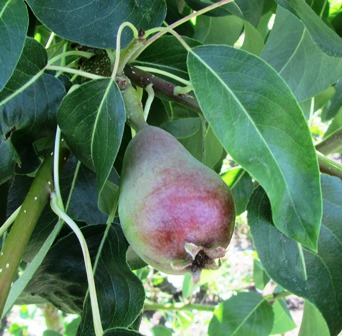
and after three years is producing dozens of late summer pears.
If you enjoy reading about country living topics, check out Meera Lester’s Henny Penny Farmette mystery series. Besides an entertaining mystery, each book includes delicious recipes, strategies for growing heirloom vegetables and fruits, and tips for keeping chickens and bees. These novels and her nonfiction self-help and wellness books are available online and everywhere books are sold.
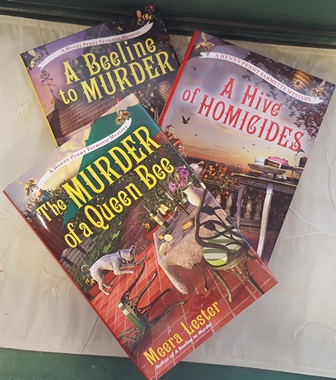
Plant Dahlias and Canna Lilies Now for Dazzling Summer Color
Love the tropical foliage and brilliant color of dahlia and Canna lily blooms? Plant them now through April if you live in Zones 8 through 11. Long prized as cut flowers for bouquets, dahlias and Canna lilies do not fail to dazzle also when grouped in flowerbeds alone or with other summer blooming plants.
Indigenous to Central Mexico, dahlias are herbaceous, leafy plants that offer blooms in a wide assortment of colors (except blue and black). Bloom size ranges from a couple of inches across to roughly a foot wide (the largest size is known as “dinner-plate”). Tall varieties need staking and all types can benefit from dead-heading when blooms are spent.
Dahlia roots are actually tubers and do best when planted in moist, well-drained, loamy soil. If growing them in areas where there is frost, dig and store the tubers in a cool, dry (and frost-free) place in the fall for re-planting the next year. In extreme climates like the high desert, dahlias benefit from several inches of mulch covering the bed.
The main pests of dahlias are slugs, snails, earwigs, leaf hoppers, and aphids. Powdery mildew and gray mold can also infect the plant.
Canna lilies, like dahlias, are herbaceous summer-blooming plants that come in a wide variety of colors. Indigenous to sub-tropical areas of North and South America, Cannas can be grown as perennials in zones 7 through 11, according to the U.S. Department of Agriculture. In other zones with more extreme climates, mulch the plants two to four inches deep or lift the rhizomes (roots) and store them in dry peat moss in a cool, dry place until ready to replant.
Plant rhizomes of tall Canna lilies at the back of the flowerbed (or at the front of the bed if the plants are dwarf) in three to six inches of rich, well-drained soil. Position so that the eyes are facing up. Pests include slugs, snails, Canna leaf-rollers, and Japanese beetles. Aphids can spread canna viruses that can cause leaf streaking and bloom disfigurement. The plants are heavy feeders so will need a good organic fertilizer when they begin to look ratty and two to four inches of water each week.
Use tall dahlias and Canna lilies at the back of your flowerbed and add mid-size blooming plants in the middle and dwarf or low growing bedding plants with lots of color at the front to create a spectacular garden area this summer. If you live in a relatively frost-free zone, your dahlias and Canna lilies will spring back to life and carry on with colorful displays amid tropical foliage for years to come.
__________________________________________________________________________________
If you enjoy reading about gardening and the natural world, check out my series of cozy mysteries that include information on growing heirloom plants and keeping chickens and bees. Also see my self-help empowerment and well-being books. All are available online and in bookstores everywhere.

The Henny Penny Farmette series of cozy mysteries–lots of delicious recipes and information for country living
CLICK ON THE LINK to see more.
Time to Harvest Seeds from Annuals
If you are like me, you hate to see anything wasted. Case in point, seeds from a summer flower garden.
Walking around my farmette this time of year, I see many seed pods on flowers that I can take off, dry, and store. Scores of my flowering plants are perennials that come back again next year, but may others are annuals, grown throughout one season.
Just because they are annuals doesn’t mean that I have to buy new seed in order to grow them next year. No. I will gather their seeds (found in flower heads or seedpods or the calyx, located at the base of the flower on the plant). I can then pull the annual and toss the plant biomass into compost pile. The seeds I’ve collected will be further dried and stored in paper envelopes labeled with the date collected and the plant’s name and color.
In the plant store you’ll find hybridized plants along with those NOT MARKED as F1 hybrids. Seeds you collect from the non-hybridized plants will come back true to their parents the next year. Non-hybrids include heirloom, open-pollinated plants that some gardeners (myself included) prefer for their gardens.
This year, I sowed zinnia seeds that I had collected two years ago. Tossing them into a bare area of the garden, I forgot about them. When they not only grew but bloomed profusely, I felt immensely pleased with myself for taking the time to collect that seed.
Zinnias are annuals. Their tiny seeds are located in the flower heads. They can be removed once the plant has finished blooming and dried.
Nasturtiums are annuals that drop their seeds (the size of a pinto bean) and will often re-seed where they’ve grown before. I like to collect these into paper envelopes and label according to color and whether they grow as a vine or bush. They actually prefer poor soil and bloom well in full sun (less so, in shade). Nasturtiums are also edible flowers–just wash, dry, and toss into a salad or use as a garnish.
Petunias are lovely annuals that carry their seed in the calyx (just under the flower). The calyx swells with seeds so you’ll want to remove the dead flowers along with the part of the stem that includes the calyx (top of stem) . Pull off the petals. When the calyx dries and splits open, you’ll see the seeds. Save these for planting.
Marigolds add splashes of bright yellow color to your garden. Remove the dead flowers and save part of the thickened stem beneath the flower head (the calyx). Split open the calyx at the top of the stem to find the long, slender seeds. Dry and save these for your next year’s flower garden.
There are lots of other annuals that you can grow in a flower garden if you take the time to harvest and dry their seeds. Consult a gardening guide or plant grower’s catalog to learn more about the annuals you might want to grow. Then give seed harvesting a try so that you’ll get all your favorite blooms in a future garden.
____________________________________________________
If you enjoy reading about gardening and other farming topics, check out my newest novel, A HIVE OF HOMICIDES. It contains not only an entertaining mystery but also tips for growing plants and trees, keeping chickens and bees, and making delicious farm-wholesome foods.
Click here to see more: http://tinyurl.com/ya5vhhpm
Helping a Kitchen Garden to Grow in Clay Soil
Under the searing summer sun, the clay soil of my farmette will grow amazing pin oaks, white oaks, and pine trees. But for a gardener like me who wants to grow vegetables and herbs, clay soil frustrates and challenges.
Before planting next year’s kitchen garden in a new area of the property, I’ll have to change the soil structure now. This will take time and a lot of effort, but it will pay huge dividends over the long term.
Here are a few things things a gardener can do to improve clay soil.
1. A few weeks before working an area, mulch the area with an eight to ten-inch layer of wood chips to help the soil retain moisture and regain structure.
2. Use a pickax to break up the soil to the depth of 10 inches and work in composted organic material.
3. Avoid working the soil after a rain or when the ground is wet because the soil will ball up into unwieldy clumps.
4. Work in sand or perlite to create more pore space for aeration and drainage. Beware of adding too much sand; the soil becomes like concrete. Ideally, the soil should have roughly fifty percent pore space with minerals and organic matter filling in the rest.
5. When not growing plants, sow a cover crop of legumes to reduce weed germination, prevent erosion, and help water penetrate deeply into the soil. A legume cover crop provides plant matter that can be turned back into the soil or mowed, leaving the plant’s bio mass in place. Legumes fix the nitrogen in the soil that will nourish the plants of the kitchen garden.
6. Repeat all of the above steps annually and dig, turn, rake, and water. Over time, the soil should support healthy roots of plants and give you a robust kitchen garden that will provide many tasty vegetables and culinary herbs.
____________________________________________________________________
If you enjoy reading cozy mysteries and are interested in gardening/farming topics, keeping bees and chickens, or creating delicious recipes from heirloom vegetables and herbs, check out my Henny Penny Farmette series. All are available from Amazon, Barnes and Noble, and other traditional and online bookstores everywhere.
Coming 9/27/17
PUBLISHERS WEEKLY 08/14/2017 noted:
“Lester’s sensitive portrayal of Abby’s struggle with her wounded psyche raises this traditional mystery above the pack.”
See more at: https://www.barnesandnoble.com/w/a-hive-of-homicides-meera-lester/1125424538?type=eBook
The Star of Spring–the Mighty Magnolia
My spouse hails from the Caribbean where a variety of magnolias grow, but many in the islands are under threat from deforestation and small distributions. He’s wanted to plant a magnolia tree since we moved to the farmette. Recently, on a rainy evening, we ventured out to our local nursery and purchased a Royal Star and a Jane magnolia for the large entrance area at the front of our property.
Often, it is the m. grandiflora that comes to mind when someone mentions a magnolia tree. It’s a big evergreen tree with glossy leaves, large tulip-shaped white flowers, and dense canopy. This tree blooms summer and fall, while other types of magnolias bloom before their leaves show in the spring.
Magnolias offer gardeners many options–evergreen or deciduous types, wide-range of flower colors, slow or fast-growing trees, and small to large and stately specimens. Named for the French botanist Pierre Magnol (1638-1715), the genus includes about 100 species.
Magnolia blossoms are fragrant and attract various pollinators. While some magnolias grow well in containers for a few years or as espaliers, the larger, showy trees are often planted along city streets and in parks.
Until we have settled on the exact planting site for each of our magnolias, they will remain in their pots. Where to plant them is an important decision since magnolias do not like to be moved once established. As a general rule, they need rich well-drained soil and benefit when the soil has plenty of organic matter like leaf mold, peat moss, and ground bark mixed in at planting time.
Magnolia trees must be planted no lower than their original soil level (where the trunk begins in the planting pot). Because they need plenty of water until established, it’s a good idea to dig a watering basin around them. Young trees must be staked to protect against wind damage.
We chose the Royal Star magnolia (magnolia stellata) because it can hold abundant and spectacular white (or pink) perfumed blossoms throughout spring into summer. Reaching a height of 15 feet with a canopy spread to 10 feet, this beauty looks magnificent against a garden fence. Such a barrier will help protect it against the wind and also create a foil for the blossoms. Come autumn, songbirds will feast on the high-fat content of the star magnolia’s capsules of orange seeds.
The Jane magnolia is one in a Little Girl series of hybrid magnolias that include: Ann, Betty, Judy, Pinkie, Randy, Ricki, and Susan. These magnolias were developed in the mid-1950s at the National Arboretum by Francis DeVos and William Kosar. Jane has large-cup flowers opening reddish-purple with white interiors. Shortly after the blossoms show, the leaves emerge as a coppery-red before turning green.
At the moment, our Jane magnolia, with its roots balled and wrapped in burlap and looking like a shrubby bush, is covered with an abundance of buds as yet unfurled. The buds hold the promise of the fragrant purple blossoms in a couple of weeks. This slow-growing magnolia will reach a height of 10 feet with a 10-foot canopy spread. The plant will be a sure show-stopper in any Northern California garden, especially in spring.
* * *
If you enjoy reading about gardening or other farm topics like keeping bees and chickens, check out my cozy mysteries–A BEELINE TO MURDER, THE MURDER OF A QUEEN BEE, and (coming Sept. 2017) A HIVE OF HOMICIDES (in the Henny Penny Farmette series from Kensington Publishing).
My farm-based novels feature delicious recipes, farming tips, chicken and beekeeping tips, sayings and, of course, a charming cozy mystery. The books are available through online retailers such as Amazon, Barnes & Noble, Target, BAM, Kobo Books, and Walmart as well as from traditional bookstores everywhere.
See, http://tinyurl.com/hxy3s8q
See, http://tinyurl.com/h4kou4g
See, http://tinyurl.com/zsxqmm3
A Forty-foot Tall Brazilian Beauty
We recently lost the elm tree that stood about 25 feet tall next to the small house on our Henny Penny Farmette. On hot days, we really feel the heat now that the elm’s shady canopy is gone. Among the trees we are considering as a replacement for the elm is a Jacaranda mimosaefolia.
This Brazilian beauty will grow to 40 feet tall and spread from 15 to 30 feet wide. The trees begin to branch profusely when they reach about 6 feet high. I love the fernlike leaves and the 8-inch long clusters of bluish-lavender tubular flowers. The tree blooms abundantly in June and is stunning in any landscape or garden.
The trees will tolerate a wide variety of soil types. Water must be consistent but too much will create profuse tender growth and too little will stunt the tree. We purchased two of these gorgeous trees and will plant them at the front of our home, far enough away from each other to allow them to mature without crowding.
Although I will miss the elm shade until the jacarandas grow large, I won’t miss the debris of seed pods and small branches easily fractured from the elm. Mature Jacaranda’s in full bloom are a sight to behold and they’re fairly easy to grow.
* * *
If you enjoy reading about farmette topics (including gardening, beekeeping, and delicious recipes), check out my cozy mysteries A BEELINE TO MURDER and also THE MURDER OF A QUEEN BEE in the Henny Penny Farmette series (from Kensington Publishing).
Enter the Goodreads Giveaway–September 29 to October 6–for a chance to win a signed copy of a first-edition hardcover of The Murder of a Queen Bee. Three lucky winners will be chosen.
These novels are chocked full of recipes, farming tips, and sayings as well as a charming cozy mystery.
The books are available through online retailers such as Amazon, Barnes & Noble, Kobo Books, and Walmart as well as from traditional bookstores everywhere.
See, http://tinyurl.com/hxy3s8q
This debut novel launched the Henny Penny Farmette series of mysteries and sold out its first press run. It’s now available in mass market paperback and other formats.
See, http://tinyurl.com/h4kou4g
Release date is THIS WEEK–September 27. This book, the second cozy mystery in the Henny Penny Farmette series, is garnering great reviews on Goodreads.com.
It’s available free on Net Galley (netgalley.com) for readers, bloggers, and other professionals who write reviews.
New Rules Mean Happier Chickens, Healthier Eggs
The Obama administration has proposed new animal welfare standards that ban common practices governing chicken farms. Currently, an organic chicken farm may allow chickens outside to roam on concrete. The new rules specify the chickens must have access to the outside and to soil.
Currently, certified organic farms allow chickens to have a specific amount and quality of outdoor activity. But that doesn’t mean access to dirt for scratching, pecking, and dust bathing that are instinctive behaviors for chickens.
Under the proposed new rules to be certified organic eggs, the chickens producing them must be allowed 1.5 square feet of space per hen indoors and 2 square feet of space outdoors. Outdoor space must be at least half soil and not have a permanent roof or flooring.
The new rules means chickens can scratch, peck, and bathe in soil instead of being caged where they do not necessarily have access to soil. Current egg producers will have five years to implement the proposed changes that also specifiy no de-beaking of chickens.
Already, McDonalds and other large food corporations have advised that they’ll be making the transition to certified organic along with Walmart. Certified organic eggs under the new rules will mean more humane and better life for the chickens producing those eggs than for chickens whose eggs are labeled “cage-free.”
Currently, cage-free eggs mean the chickens producing those eggs do not necessarily get access to the outdoors as the new O’bama administration rules propose.
There will be a sixty day comment period before the rules can go into effect. But for animal protection advocates and supporters of the organic food movement, the new proposed rules are a welcome change.
* * *
If you enjoy reading about farmette topics (including gardening, beekeeping, and delicious recipes), check out my cozy mysteries A BEELINE TO MURDER and also THE MURDER OF A QUEEN BEE in the Henny Penny Farmette series (from Kensington Publishing).
Both are available through online retailers such as Amazon, Barnes & Noble, and Walmart as well as from traditional bookstores everywhere.
Now available in mass market paperback, this novel launched the Henny Penny Farmette series of mysteries and sold out its first press run.
The second cozy mystery in the Henny Penny Farmette series, available Sept. 29, 2016
From Garden to Table, Easy-to-Grow Squash
I love summer squash, tossed into rosemary potatoes and served up with eggs and sausage on a Sunday morning; or, grilled with fish, or added to a freshly-made pasta sauce. Best of all, you can have it fresh, from your kitchen garden to your table, as squash is one of the easiest vegetables to grow. Squash is a super food, high in antioxidants, fiber, and Vitamin A.
Squash is one of the Three Sisters (corn and climbing beans being the other two), grown together as companion plants in the tradition of certain groups of Native Americans who planted these vegetables. A fourth sister might be the Cleome serrulata, the Rocky Mountain bee plant to attract pollinators for the beans and squash.
There is a scientific basis for growing these three together. The squash grows fairly large and spreads out, blocking weeds. The beans provide nitrogen to the soil. The corn shoots up a stalk that provides the support the beans need to climb. The three plants benefit each other.
Each year, I plant both summer squash and winter varieties such as butternut and pumpkin that have hard shells and store longer. All types of squash are easy to grow. They just need sun, water, and room. They aren’t fussy about soil.
Summer squash includes zucchini, yellow squash, and scalloped (or round) squash. Autumn/winter varieties require a longer growing period (up to 120 days) and include butternut, acorn, hubbard, and pumpkin.
Growing Tips:
Choose a well-drained, sunny spot in the garden for your squash.
Plant three seeds to a hill (roughly six inches apart).
When the squash are about a foot tall, thin to the healthiest seedling.
Water two to three times each week.
Harvest summer squash when still young; if left on the vine, the squash becomes tough.
Tell the Plants to Go Back to Sleep . . . It’s Still Winter
It’s beach weather along Northern California’s coastline and bare root season technically won’t start for another few weeks. It’s the last Saturday in January–still winter. But the plants are waking up all around Henny Penny Farmette, thanks to the record-breaking, unseasonably warm weather.

Narcissus are grown from bulbs and when massed together in plantings return year after year in a cheerful splash of color
The narcissus seem to have popped up overnight. We tucked three dozen bulbs in a bed the first fall we lived on the farmette. The next spring, they bloomed. Their tall stalks and leaves die during summer, but every spring they emerge to bloom again, creating a dramatic drift of color.
Who doesn’t love working in shirt sleeves? But our gardens need rain and we need the plants to remain dormant while we finish winter chores and get our new chicken house ready.
This week, we finished dividing the strawberries and irises, cutting back the roses, and spraying the fruit trees again.We created another sitting area in the garden under a large apricot tree, laid a gravel floor, and planted Bird of Paradise (Strelitzia reginae) plants in half barrels.
Bird of Paradise plants (also known as crane flower) are indigenous to South Africa. The plants are heat lovers and aren’t too fussy about soil. Planting them in containers is a good idea if you live in an area, as we do, where the winter temperatures fall below 50 degrees Fahrenheit. You simply move them indoors.
The Bird of Paradise foliage makes a nice foil for the plant’s striking blooms of orange, fuchsia, and purple that resemble a crane’s head and beak.
I think it’s too late to tell the plants to go back to sleep. So even if it’s torture to spend a long, languorous day digging in my garden in my shirt sleeves, while the rest of the country is freezing, I suppose I simply must soldier on.
Early December Farmette Chores
I arose early today as I have for the last few months, eager to greet the rising sun even as the days grow shorter as we head toward the winter solstice. I stand with eyes closed facing east until the light blazes against my lids, almost lighting my being from the inside. Then I say prayers–my way to start the day off right.
The fruit trees have changed leaf color and dropped most of their foliage. I helped them along today, collecting up all the fallen leaves and putting them in the green recycle bin. With the leaves gone, I can use an organic spray to prevent overwintering of fungi and pests. Similarly, I pluck the leaves from the tea roses and cut the canes to a height of between 12-18 inches.
With the spade, I turned the soil around the base of most of the fruit trees to aerate the soil in preparation for adding some amendments like compost. I twisted the remaining pumpkins off the vine and tossed the vines (which were still blooming and setting up fruit) into the compost pile. It’ll be freezing soon, so I’m just getting a head start.
I put food in all the bird feeders and hung some suet for the woodpeckers. Finally, I raked an area under the pepper tree for the new, smaller hen house that Carlos will build sometime this month since we plan to acquire some new chickens in January. In all, it has been a very productive day . . . one of many scheduled for this month, the last month of the year.
 Facebook
Facebook Goodreads
Goodreads LinkedIn
LinkedIn Meera Lester
Meera Lester Twitter
Twitter









